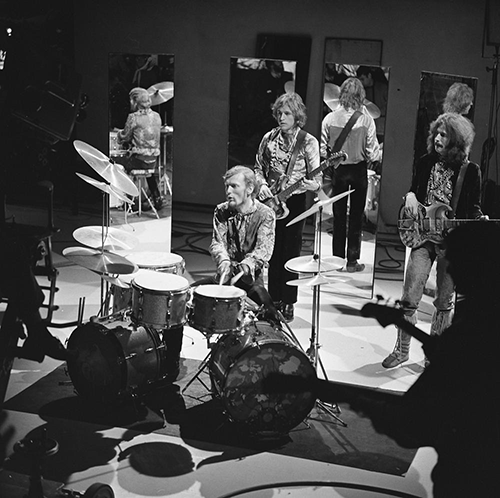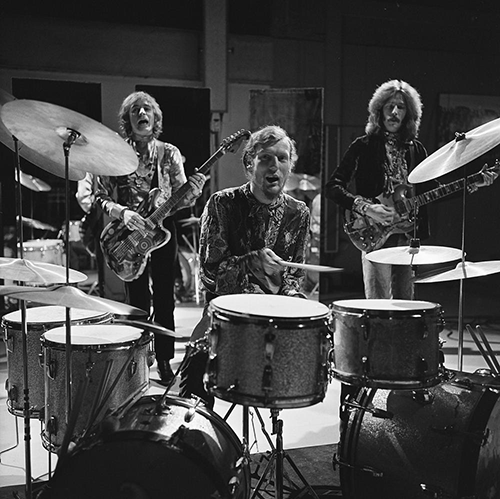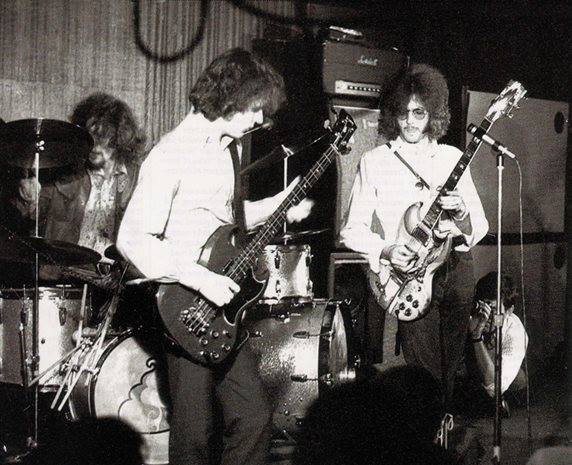Photo: Harry Bruce.
Cream (band)
Origin London, England
Genres Psychedelic rock, blues rock, hard rock
Years active 1966–1968
(Reunions: 1993, 2005)
Labels Reaction, Polydor, Atco, RSO, Reprise
Cream were a 1960s British rock supergroup power trio consisting of bassist/singer Jack Bruce, drummer Ginger Baker, and guitarist/singer Eric Clapton. The group’s third album, Wheels of Fire (1968), was the world’s first platinum-selling double album. The band is widely regarded as the world’s first successful supergroup. In their career, they sold more than 15 million copies of their albums worldwide. Their music included songs based on traditional blues such as “Crossroads” and “Spoonful”, and modern blues such as “Born Under a Bad Sign”, as well as more eccentric songs such as “Strange Brew”, “Tales of Brave Ulysses” and “Toad”.
The band’s biggest hits were “I Feel Free” (UK number 11), “Sunshine of Your Love” (US number 5), “White Room” (US number 6), “Crossroads” (US number 28), and “Badge” (UK number 18).
YOUTUBE
The band made a significant impact on the popular music of the time, and, along with Jimi Hendrix and other notable guitarists and bands, popularised the use of the wah-wah pedal. They provided a heavy yet technically proficient musical theme that foreshadowed and influenced the emergence of British bands such as Led Zeppelin, The Jeff Beck Group, Deep Purple and Black Sabbath in the late 1960s and the early 1970s. They also had an impact on American southern rock leading groups The Allman Brothers Band and Lynyrd Skynyrd. The band’s live performances influenced progressive rock acts such as Rush.
The band was inducted into the Rock and Roll Hall of Fame in 1993.[ They were included in both Rolling Stone and VH1’s lists of the “100 Greatest Artists of All Time,” at number 67 and 61 respectively. They were also ranked number 16 on VH1’s “100 Greatest Artists of Hard Rock”.
By July 1966, Eric Clapton’s career with The Yardbirds and John Mayall & the Bluesbreakers had earned him a reputation as the premier blues guitarist in Britain. Clapton, however, found the environment of Mayall’s band confining, and sought to expand his playing in a new band. In 1966, Clapton met Ginger Baker, then the leader of the Graham Bond Organisation, which at one point featured Jack Bruce on bass guitar, harmonica and piano. Baker felt stifled in the Graham Bond Organisation and had grown tired of Graham Bond’s drug addictions and bouts of mental instability. “I had always liked Ginger”, explained Clapton. “Ginger had come to see me play with the Bluesbreakers. After the gig he drove me back to London in his Rover. I was very impressed with his car and driving. He was telling me that he wanted to start a band, and I had been thinking about it too.”
Each was impressed with the other’s playing abilities, prompting Baker to ask Clapton to join his new, then-unnamed group. Clapton immediately agreed, on the condition that Baker hire Bruce as the group’s bassist; according to Clapton, Baker was so surprised at the suggestion that he almost crashed the car. Clapton had met Bruce when the bassist/vocalist briefly played with the Bluesbreakers in November 1965; the two also had worked together as part of a one-shot band called Powerhouse (which also included Steve Winwood and Paul Jones). Impressed with Bruce’s vocals and technical prowess, Clapton wanted to work with him on an ongoing basis.
In contrast, while Bruce was in Bond’s band, he and Baker had been notorious for their quarrelling. Their volatile relationship included on-stage fights and the sabotage of one another’s instruments. After Baker fired Bruce from the band, Bruce continued to arrive for gigs; ultimately, Bruce was driven away from the band after Baker threatened him at knifepoint.
Baker and Bruce put aside their differences for the good of Baker’s new trio, which he envisioned as collaborative, with each of the members contributing to music and lyrics. The band was named “Cream”, as Clapton, Bruce, and Baker were already considered the “cream of the crop” amongst blues and jazz musicians in the exploding British music scene. Initially, the group were referred to and billed as “The Cream”, but starting officially with its first record releases, the trio came to be known as “Cream”. Before deciding upon “Cream”, the band considered calling themselves “Sweet ‘n’ Sour Rock ‘n’ Roll”. Of the trio, Clapton had the biggest reputation in England; however, he was all but unknown in the United States, having left The Yardbirds before “For Your Love” hit the American Top Ten.
Photo: Harry Bruce.
The band made its unofficial debut at the Twisted Wheel on 29 July 1966. Its official debut came two nights later at the Sixth Annual Windsor Jazz & Blues Festival. Being new and with few original songs to its credit, they performed blues reworkings that thrilled the large crowd and earned it a warm reception. In October the band also got a chance to jam with Jimi Hendrix, who had recently arrived in London. Hendrix was a fan of Clapton’s music, and wanted a chance to play with him onstage.
It was during the early organisation that they decided Bruce would serve as the group’s lead vocalist. While Clapton was shy about singing, he occasionally harmonised with Bruce and, in time, took lead vocals on several Cream tracks including “Four Until Late”, “Strange Brew”, “World of Pain”, “Outside Woman Blues”, “Anyone for Tennis”, “Crossroads”,and “Badge.
Rock and Roll Hall of Fame
In 1993, Cream were inducted into the Rock and Roll Hall of Fame and reformed to perform at the induction ceremony. Initially, the trio were wary about performing, until encouraging words from Robbie Robertson inspired them to try. The set consisted of “Sunshine of Your Love”, “Crossroads”, and “Born Under a Bad Sign”, a song they had not previously played live. Clapton mentioned in his acceptance speech that their rehearsal the day before the ceremony had marked the first time they had played together in 25 years. This performance spurred rumours of a reunion tour. Bruce and Baker said in later interviews that they were, indeed, interested in touring as Cream. A formal reunion did not take place immediately, as Clapton, Bruce and Baker continued to pursue solo projects, although the latter two worked together again in the mid-1990s as two-thirds of a power trio BBM with Irish blues rock guitarist Gary Moore.
At Clapton’s request, Cream reunited for a series of four shows, on 2, 3, 5, and 6 May 2005 at the Royal Albert Hall in London, the venue of their final concerts in 1968. Although the three musicians chose not to speak publicly about the shows, Clapton would later state that he had become more “generous” in regard to his past, and that the physical health of Bruce and Baker was a major factor:[43] Bruce had recently undergone a liver transplant for liver cancer, and had almost lost his life, while Baker had severe arthritis.
Tickets for all four shows sold out in under an hour. The performances were recorded for a live CD and DVD. Among those in attendance were Bill Wyman, Steve Winwood, Paul McCartney, Ringo Starr, Roger Waters, Brian May, Jimmy Page, and Mick Taylor. The reunion marked the first time the band had played “Badge” and “Pressed Rat and Warthog” live.
Inspired by the success of the reunion, the band agreed to an additional set of three shows at the Madison Square Garden in New York City, from 24–26 October 2005. According to Clapton, these concerts didn’t live up to the Royal Albert Hall performances due to, among other reasons, lack of rehearsal and the resurgence of old grudges among band members.
In February 2006, Cream received a Grammy Lifetime Achievement Award in recognition of their contribution to, and influence upon, modern music. That same month, a “Classic Albums” DVD was released detailing the story behind the creation and recording of Disraeli Gears. On the day prior to the Grammy ceremony, Bruce made a public statement that more one-off performances of Cream had been planned: multiple dates in a few cities, similar to the Royal Albert Hall and Madison Square Garden shows.
Photo: Harry Bruce.
However, this story was refuted by both Clapton and Baker, first by Clapton in a Times article from April 2006. The article stated that when asked about Cream, Clapton said: “No. Not for me. We did it and it was fun. But life is too short. I’ve got lots of other things I would rather do, including staying at home with my kids. The thing about that band was that it was all to do with its limits … it was an experiment.” In an interview in the UK magazine Music Mart, about the release of a DVD about the Blind Faith concert in Hyde Park 1969, Baker commented about his unwillingness to continue the Cream reunion. These comments were far more specific and explosive than Clapton’s, as they were centred around his relationship with Jack Bruce. Ginger said, “When he’s Dr. Jekyll, he’s fine … It’s when he’s Mr. Hyde that he’s not. And I’m afraid he’s still the same. I tell you this – there won’t ever be any more Cream gigs, because he did Mr. Hyde in New York last year.”
The headlining act for the O2 Arena Ertegun tribute show (postponed to December 2007) turned out to be another reunited English hard-rock act, Led Zeppelin. In an interview with BBC 6 Music in April 2010, Bruce confirmed that there would be no more Cream shows. He said: “Cream is over”.
On 25 October 2014, Bruce died of liver disease in Suffolk, England at the age of 71.
Discography
Cream discography
Fresh Cream (1966)
Disraeli Gears (1967)
Wheels of Fire (1968)
Goodbye (1969)
External links below.
Fresh Cream (1966)- Disraeli Gears (1967)
- Wheels of Fire (1968)
- Goodbye (1969)



